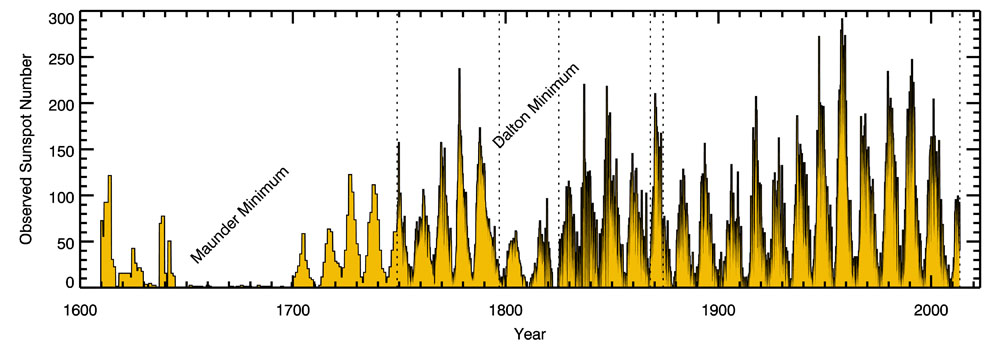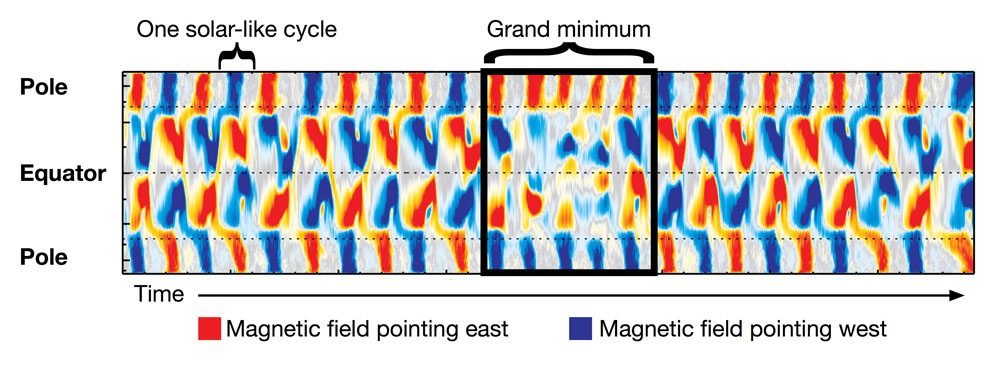Capturing a sleeping Sun
NCAR model first to spontaneously simulate a grand minimum
Nov 5, 2015 - by Staff
Nov 5, 2015 - by Staff
November 6, 2015 | Three hundred years ago, the Sun began to wake up.
For 70 years—from about 1645 to 1715—the Sun had been eerily quiet, with very few sunspots erupting on its surface. This prolonged period of muted activity, known as the Maunder Minimum, is the most dramatic so-called "grand minimum" ever recorded by humans.
Scientists think that grand minima of a similar scale occurred before the Maunder Minimum and that more are likely in the future. But their origins remain an enigma.
Recently, however, scientists at NCAR's High Altitude Observatory—using a 3-D computer model of the same wild and swirling magnetic processes that are thought to be unfolding in the real Sun—may have uncovered an important clue. Their model, which they hoped would simply mimic the Sun's more workaday (though still mysterious) 11-year solar cycle, spontaneously plunged into its own grand minimum. And then, maybe more importantly, it recovered.
This is the first time such a simulation has slid into, and out of, a grand minimum. The result, published in The Astrophysical Journal, is exciting because it tells researchers that the fundamental equations they've used to program their models are providing a closer representation of the Sun.
"These types of simulations will help us understand the basic physics of how order emerges out of the chaos of magnetic fields that is the Sun," said NCAR scientist Mark Miesch, who worked on the model with postdoctoral fellow Kyle Augustson.

Astronomers began recording their observations of sunspots with telescopes around 1600. This chart of those observations highlights two minima, when sunspot activity decreased over multiple solar cycles. (Image courtesy Kyle Augustson.)
Like the Earth, the Sun has a magnetic field. But compared to the Earth's field, which is relatively predictable and sedate, the Sun's field is constantly shifting. Scientists know the behavior of the Sun's magnetic field is connected to its solar cycle—the rise and fall of activity that occurs every 11 years or so—as well as to the birth of individual sunspots, and to the longer-term phenomena of grand minima and maxima. But they are still working to nail down the physics of how the magnetic field forms and evolves.
Generally, solar scientists have relied on two types of models to help them better understand the physics of the Sun. The first type, now used to help forecast space weather, are 2-D models that simplify the Sun's unruly magnetic fields by averaging them over longitude. These models are useful for focusing on large-scale phenomena, such as the periodic magnetic field reversals at the Sun's north and south poles that accompany the waxing and waning of sunspot activity.
These models use observations to mimic the solar cycle as closely as possible. But they can't capture the seething turbulence beneath the surface, which is ultimately responsible for the complex and vibrant array of magnetic activity that scientists are able to see at the surface.
For a deeper look, scientists use 3-D magnetohydrodynamic (MHD) simulations, which tackle the complex interactions between the Sun's roiling interior and its surface. Such simulations rely on the fundamental equations that solar physicists suspect govern the Sun's magnetic activity. Solar observations are not fed into these models to nudge them toward a realistic representation of the Sun. Instead, scientists leave these models to run more or less on their own and watch to see if they will produce cyclic behavior, like the Sun does, despite the simulated turbulence in the model.
"The first approach is more practical in a way," Miesch said. "There is no guarantee that the second approach will give you anything that even remotely looks like the Sun. However, when it does, it's exciting and the implications can be profound."
Augustson and Miesch were pleased to find that the simulation produced by their model did, in fact, resemble the Sun. During the first week the model was running on a NASA supercomputer, the model slipped into a steady rhythm. The magnetic field in the simulation reversed direction at regular intervals, just as the Sun's does with each solar cycle. The model also showed a regular migration of magnetic field structures toward the equator and the poles, which is characteristic of the pattern that emerges from sunspot behavior.
Then, about a day into the second week of running the model, something changed. At first, the researchers were concerned that the model's cyclic behavior had fizzled out. But only 12 hours later, the regular solar-like cycles returned. Augustson and Miesch realized that the model had simulated a grand minimum, which meant that the model resembled the Sun even more closely than they had hoped.
Since this and other recent MHD simulations have displayed behavior similar to that of the Sun, there is growing confidence that the equations underlying such simulations are beginning to reflect what might be happening beneath the Sun’s surface.
"Indeed, this simulation, and its brethren, are a promising step toward understanding the long-term behavior of the Sun’s magnetism from the perspective of the turbulence present in the solar interior,” Augustson said.

The 3-D model built by researchers at NCAR's High Altitude Observatory mimics some aspects of the Sun's behavior, providing insight into what's driving the Sun's mysterious magnetic field.
The image above shows how the magnetic field of the model Sun changed over the life of the modeling run. Just as occurs on the real Sun, the simulation slipped into a predictable rhythm at first, with magnetic field directions reversing with each cycle.
The image also shows how the magnetic activity in the mid-latitudes tends to march toward the equator before dissipating, flipping, and reappearing farther away from the equator again. The butterfly shape of the magnetic activity in the mid-latitudes is similar to the pattern of sunspot activity seen on the real Sun.
About halfway through the pictured run, the model's behavior changed. The magnetic direction stopped flipping and the magnetic activity in the mid-latitudes decreased, indicating that the model had entered a grand minimum. The Sun has gone through similar periods of low activity during recorded history.
The movie, below, also shows how the model's magnetic field evolved over time. At around two minutes, the model begins a grand minimum.
Kyle Augustson, Allan Sacha Brun, Mark Miesch, and Juri Toomre, Grand Minima and equatorward propagation in a cycling stellar convective dynamo, The Astrophysical Journal, doi: 10.1088/0004-637X/809/2/149
Writer/Contact
Laura Snider, Senior Science Writer and Public Information Officer
Funder
NASA